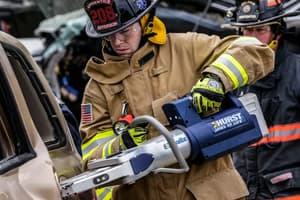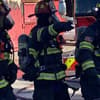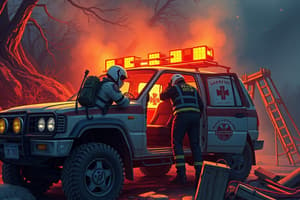Podcast
Questions and Answers
What is the purpose of procedure 316?
What is the purpose of procedure 316?
- To provide procedures for vehicle extrication operations (correct)
- To establish protocols for incident management
- To provide procedures for dealing with a fire incident
- To provide procedures for handling hazardous materials incidents
What information should the first arriving unit provide to dispatch?
What information should the first arriving unit provide to dispatch?
- Unit on-scene and weather conditions
- Initial scene size-up and weather conditions
- Number of units on-scene and road conditions
- Unit on-scene, initial scene size-up, and establishment of incident command (IC) (correct)
What should the IC confirm about dispatched units?
What should the IC confirm about dispatched units?
- Proper communication equipment carried by units
- Presence of hazardous materials response team
- Availability of medical personnel
- Dispatch of full vehicle extrication tools and trained personnel (correct)
What does the IC need to establish besides fire suppression and extrication teams?
What does the IC need to establish besides fire suppression and extrication teams?
What is the purpose of performing a 360 assessment?
What is the purpose of performing a 360 assessment?
What tools should be included in the dispatched units for extrication operations?
What tools should be included in the dispatched units for extrication operations?
What should be assumed about the vehicles until reasonably confirmed otherwise?
What should be assumed about the vehicles until reasonably confirmed otherwise?
What should be used to develop an initial incident action plan and for ongoing operations?
What should be used to develop an initial incident action plan and for ongoing operations?
What should be confirmed before engaging in extrication of electric or hybrid vehicles?
What should be confirmed before engaging in extrication of electric or hybrid vehicles?
What should be stored with the DOT Emergency Response guidebook in all department vehicles?
What should be stored with the DOT Emergency Response guidebook in all department vehicles?
What should be avoided and worked around unless advised otherwise by the IC or extrication officer?
What should be avoided and worked around unless advised otherwise by the IC or extrication officer?
What can compromise vehicle stability without warning during extrication activity?
What can compromise vehicle stability without warning during extrication activity?
Before releasing units from any scene where personnel were exposed to potentially harmful substances, what should the IC ensure?
Before releasing units from any scene where personnel were exposed to potentially harmful substances, what should the IC ensure?
What should the extrication team do if the vehicle is on its side or overturned?
What should the extrication team do if the vehicle is on its side or overturned?
What should the extrication team do to disable the vehicle?
What should the extrication team do to disable the vehicle?
What should at least one firefighter do during pre-extrication fire suppression operations?
What should at least one firefighter do during pre-extrication fire suppression operations?
What should be avoided when placing stabilization equipment against electric or hybrid vehicles?
What should be avoided when placing stabilization equipment against electric or hybrid vehicles?
What should the extrication officer do to avoid cutting into fuel delivery, high-voltage, or high-pressure components?
What should the extrication officer do to avoid cutting into fuel delivery, high-voltage, or high-pressure components?
What should personnel wear when advised that full PPE is not needed during extrication operations?
What should personnel wear when advised that full PPE is not needed during extrication operations?
What should be done if a commercial vehicle is involved?
What should be done if a commercial vehicle is involved?
When should suppression and extrication operations not begin?
When should suppression and extrication operations not begin?
What should be done if any of several indicators or conditions are present?
What should be done if any of several indicators or conditions are present?
Who should establish a marked extrication zone?
Who should establish a marked extrication zone?
Flashcards are hidden until you start studying
Study Notes
Procedure 316 Purpose
- Establishes protocols for responding to vehicle extrication incidents.
- Ensures safety and efficiency during emergencies involving vehicles.
First Arriving Unit Responsibilities
- Provide incident location, type, and number of vehicles involved.
- Notify dispatch of conditions upon arrival, including hazards.
IC Confirmation
- Confirm the number and type of units dispatched to the scene.
- Verify the operational status of incoming units for effective coordination.
Additional Establishments by IC
- Set up medical and command teams alongside fire suppression and extrication units.
- Establish a safe perimeter for the incident.
360 Assessment Purpose
- Conduct a comprehensive evaluation of the incident scene.
- Identify hazards, resources needed, and the layout of the vehicles involved.
Tools for Extrication Operations
- Include hydraulic tools, cutting devices, and stabilization equipment in dispatched units.
- Prepare equipment that addresses specific vehicle types and conditions.
Vehicle Assumptions
- Assume vehicles may contain hazardous materials until confirmed otherwise.
- Consider potential dangers from airbags, fuel sources, and electrical systems.
Initial Incident Action Plan Development
- Use assessment findings to formulate the initial incident action plan.
- Adapt the plan for ongoing operations based on changing conditions and needs.
Confirmation for Electric/Hybrid Vehicles
- Confirm the presence of high-voltage components before engaging in extrication.
- Ensure safety protocols are followed to avoid electric hazards.
Storage of Guidelines
- Store the DOT Emergency Response Guidebook with all department vehicles.
- Ensure accessibility for quick reference during incidents.
Hazards to Avoid
- Avoid working near or around potential hazards unless directed by the IC or extrication officer.
- Exercise caution around unstable structures or dangerous materials.
Vehicle Stability Concerns
- Be aware that vehicle stability can change without warning during extrication activities.
- Monitor the situation closely to ensure personnel safety.
Personnel Exposure Protocol
- Ensure personnel who may have been exposed to harmful substances are accounted for before releasing units.
- Conduct decontamination procedures as necessary.
Actions for Sideways or Overturned Vehicles
- Stabilize the vehicle properly before starting extrication.
- Utilize appropriate tools and techniques for securing the vehicle.
Vehicle Disabling Procedures
- Disconnect the battery to prevent electrical hazards.
- Engage safety protocols specific to the type of vehicle.
Pre-Extrication Fire Suppression
- At least one firefighter should be assigned to fire suppression while extrication is underway.
- Maintain safety oversight during operations.
Stabilization Equipment Use
- Avoid placing stabilization equipment against components of electric or hybrid vehicles that could be damaged.
- Ensure safe equipment placement to prevent accidental activation.
Extrication Officer Precautions
- The extrication officer should mark precise locations to avoid cutting into critical components.
- Maintain communication with the team to ensure safety.
PPE Management
- Personnel should wear appropriate gear, even when advised that full PPE is unnecessary.
- Follow guidelines to ensure safety throughout operations.
Commercial Vehicle Involvement
- Follow specific procedures if a commercial vehicle is involved, considering dimensions and weight.
- Adjust tactics to accommodate risks associated with larger vehicles.
Suppression and Extrication Operations Delays
- Hold operations if conditions indicate potential hazards, such as structural instability or unknown materials.
- Assess risks before proceeding to ensure personnel safety.
Response to Indicators or Conditions
- Implement specific protocols if indicators like gas leaks or electrical issues are present.
- Prioritize safety and risk mitigation measures.
Marked Extrication Zone Establishment
- The IC should designate a marked extrication zone to protect personnel during operations.
- Ensure all teams are aware of the designated safe area for enhanced safety.
Studying That Suits You
Use AI to generate personalized quizzes and flashcards to suit your learning preferences.






